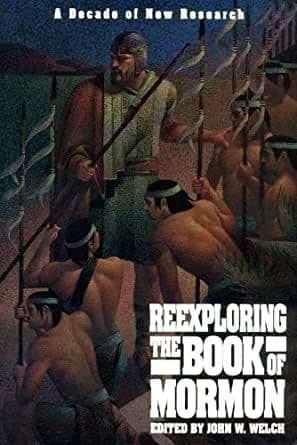Book
85 Chapters

Alma 46:22 “even as we have cast our garments at thy feet to be trodden under foot”
At one point in his ministry, Isaiah was instructed by the Lord to remove his garment and shoes and walk “naked [like a slave, without an upper garment] and barefoot” among the people. Isaiah’s action was to be a sign, for as Isaiah walked like a slave, even so would the Egyptians become slaves to the Assyrians (Isaiah 20:2-4). This prophetic symbolic action by Isaiah represented a prophetic curse that destruction and ruin would come upon the Egyptians.
Ezekiel conducted a symbolic act that had anathematical tones. He cut off the hair of his beard and his head, and divided it into three portions. One third Ezekiel burned, one third he scattered into the wind, and one third he smote with a knife. This was a prophetic curse, demonstrating the three ways in which Israel would perish—by fire, by scattering, and by the sword of war (see Ezekiel 5:1-17).
Such prophetic symbolic curses are well attested in the Bible.1 Fohrer and Aune take a broad approach to prophetic symbolic actions, listing several examples (see, for instance, Numbers 21:6-9; 1 Kings 22:11; 2 Kings 13:14-19; Isaiah 2:9-10; 3:1-4; 8:1-4; 7:10-17; Jeremiah 19:1-15; 27-28; 28:10-11; 32:6-44; Ezekiel 4:1-3; 4:4-8; 4:9-17). Several F.A.R.M.S. publications have previously noted various types of symbolic actions that are present in the Book of Mormon.2
Book of Mormon prophets carried on the Old World tradition of performing symbolic actions that revealed a prophetic curse. The incident of the title of liberty was much more than a rally behind a standard. Moroni rent his coat, wrote upon it the title of liberty, placed it upon a pole, and “went forth among the people, waving the rent part of his garment in the air, that all might see” (Alma 46:19). After this dramatic act, Moroni likened his rent coat to the garment of Joseph that had been rent by Joseph’s brothers and proclaimed, “Let us remember to keep the commandments of God, or our garments shall be rent by our brethren, and we be cast into prison, or be sold, or be slain” (Alma 46:23). A curse is clearly implied. Those who fail to keep the commandments of God would be imprisoned, sold, or slain.
Those who witnessed Moroni’s symbolic activity responded in turn with another symbolic action by casting their garments at Moroni’s feet and then promising not to fall into transgression, lest God “cast us at the feet of our enemies, even as we have cast our garments at thy feet to be trodden under foot” (Alma 46:22).
A prophetic symbolic action accompanied by a curse is found in the hanging of Zemnarihah on the top of a tree. After his death the Nephites felled the tree and called out in unison, “May the Lord preserve his people in righteousness and in holiness of heart, that they may cause to be felled to the earth all who shall seek to slay them . . . even as this man hath been felled to the earth” (3 Nephi 4:28-29). This act predicted the way the wicked would be slain if they continued their attempts to murder the righteous.
A third example of symbolic action as a prophetic curse is found in the episode of the scalping of Zerahemnah. After Moroni’s soldier scalped Zerahemnah, the warmongering leader of the Lamanites, the soldier displayed the scalp on the point of his sword and stated with a loud voice, “Even as this scalp has fallen to the earth . . . so shall ye fall to the earth except ye will deliver up your weapons of war and depart with a covenant of peace” (Alma 44:12-14).
The symbolic actions in these examples were so effective that in each instance the audience reacted immediately and positively. Those who viewed Moroni gathered around the title of liberty; those who witnessed the felling of the tree had a great emotional and spiritual experience (see 3 Nephi 4:30-33); and the followers of Zerahemnah who were present when he was scalped “were struck with fear” and “threw down their weapons of war,” promising to live in peace (Alma 44:15).
Based on research by Donald W. Parry, July 1991.
1. Georg Fohrer, Die symbolischen Handlungen der Propheten (Zürich: Zwingli Verlag, 1953), 17-19, and David E. Aune, Prophecy in Early Christianity and the Ancient Mediterranean World(Grand Rapids: Eerdmans, 1983), 100-101.
2. Mark Morrise, “Simile Curses in the Ancient Near East, Old Testament, and Book of Mormon” (Provo: F.A.R.M.S., 1982); and Terrence Szink, “An Oath of Allegiance in the Book of Mormon,” in Warfare in the Book of Mormon, ed. Stephen Ricks and William Hamblin (Salt Lake City: Deseret Book and F.A.R.M.S., 1990), 36-38, present examples of simile curses. John W. Welch discusses parabolic acts performed by prophetic oracles, in “Law and War in the Book of Mormon,” in Warfare in the Book of Mormon, 62; see also pages 239-41, “Was Helaman 7-8 an Allegorical Sermon?” in this book.
Book
85 Chapters
Items in the BMC Archive are made publicly available for non-commercial, private use. Inclusion within the BMC Archive does not imply endorsement. Items do not represent the official views of The Church of Jesus Christ of Latter-day Saints or of Book of Mormon Central.